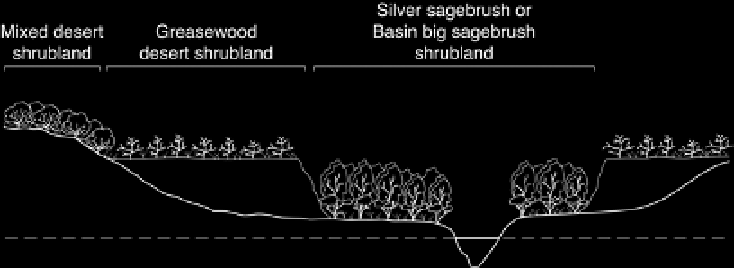Geoscience Reference
In-Depth Information
Fig. 8.5. Greasewood is common on
terraces along many ephemeral streams,
with basin big sagebrush and plains sil-
ver sagebrush in ravine bottoms, where
salts are washed downstream more
f frequently.
Root sprouting also produces new shrubs. At least four
kinds of greasewood communities have been identi-
fied: greasewood-shadscale, greasewood-big sagebrush,
Big sagebrush occurs with greasewood only sporadi-
cally, where the soils have a higher infiltration rate and
are less saline.
normally greasewood grows at low points in the
landscape, but an interesting anomaly sometimes occurs
in desert riparian zones, where greasewood shrublands
are found on terraces and basin big sagebrush in ravine
bottoms, closer to the water table (fig. 8.5). Basin big
sagebrush grows quite well in the ravine environment,
probably because of frequent flooding that washes away
many of the salts that might otherwise accumulate and
inhibit the establishment of sagebrush seedlings. Also,
the ravine bottom soils tend to be more permeable than
wood apparently receives adequate water on the terraces.
Some saline depressions have no shrubs and are bet-
ter referred to as saltgrass meadows. they are charac-
terized by inland saltgrass, alkaligrass, alkali sacaton,
and, in wetter areas, alkali cordgrass. Several halophytic
members of the goosefoot family are present here as
well. one, red swampfire (
Salicornia rubra
), is a small
succulent plant that turns bright red in the fall and
seems well adapted to
slickspot soils
—a name derived
from the slippery soil that develops after a rain because
of the soil-particle-dispersing effect of high sodium
concentrations. Red swampfire commonly forms a
band closest to the water, with concentric bands of
saltgrass meadow, greasewood shrubland, and mixed
desert shrubland occurring as distance from the pond
tern is for saline meadows with inland saltgrass and its
associates to be dotted with low mounds, where much
taller alkali sacaton grows. the mounds very likely are
the result of silt deposition around the taller grass. Blue
grama and western wheatgrass can be found with the
saltgrass in some places, though these species are less
tolerant of soil salinity.
inland saltgrass has been the subject of several stud-
ies because of its value as a forage plant. it normally
saltgrass does not concentrate salts in its tissues. Seeds
of this grass germinate only when relatively high soil
moisture coincides with optimal seedbed temperature,
and when the available soil water is adequate to dilute
the salts. the same might be true for many desert plants.
Mixed desert shrubland occurs in dry upland habitats
(fig. 8.6). characteristic shrubs are shadscale, bud sage-
wort, winterfat, spiny hopsage, and Gardner's saltbush
(table 8.1). Shadscale is more common on dry, some-
what sandier soils; spiny hopsage is common on sandy
soils where snow accumulation is higher; and winterfat
is more common on fine-textured soils (with more silt
and clay). Big sagebrush can be found in ravines, where
the soil is less saline and where water infiltration into
sagebrush is thought to be intolerant of saline or alkaline
plant species composition and growth are a function of
topography, aspect, snow accumulation, parent material,
and other factors—not just soil pH or conductivity. no
single factor explains why plants grow where they do.
Desert pavement and coppice dunes are common in
mixed desert shrublands. Silt and sand are easily eroded
by wind, leaving a surface of pebbles. the windblown

Search WWH ::

Custom Search